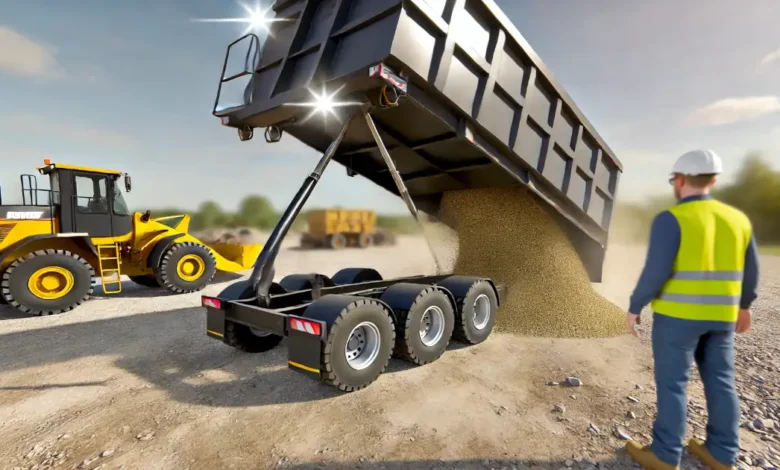Tip Trailers: A Comprehensive Guide to Choosing and Using the Right Tipping Trailer

In today’s industrial and agricultural world, tip trailers are vital tools that boost efficiency, simplify heavy loads, and ensure seamless unloading. Whether you’re working on a construction site, a farm, or a landscaping project, the right-tip trailer can make a world of difference. However, choosing the perfect trailer, understanding its functions, and learning how to maintain it can seem daunting. This guide provides a complete look at tip trailers to help you make an informed decision.
What is a Tip Trailer?
A tip trailer, also known as a dump trailer or tipping trailer, is a specialized trailer that can be tilted to unload its contents quickly. This function is possible by a hydraulic system that raises the trailer bed, letting gravity work to release the load. With various types and sizes available, tip trailers cater to diverse needs, from hauling soil and gravel to handling waste and agricultural produce.
Why Use a Tip Trailer?
The primary reason to use a tip trailer is efficiency. Traditional loading and unloading require significant manpower and time, while a tip trailer reduces this labor and speeds up the process. Here are some major benefits of using a tip trailer:
- Enhanced Productivity: Faster unloading leads to quicker turnaround times on job sites.
- Versatility: Can handle various materials, from sand and soil to rocks and debris.
- Safety: Reduces manual handling, which lowers the risk of injuries associated with heavy lifting.
- Cost Efficiency: Saves on labor costs due to automated unloading.
Types of Tip Trailers
Tip trailers come in several types, each with unique features suitable for different tasks. Choosing the right type of hydraulic unloading trailer depends on your requirements and work environment.
- End Tipper: The most common type, an end tipper unloads materials by tipping backward, with materials exiting from the rear. Ideal for construction sites, end tippers can handle high loads and are easy to operate.
- Side Tipper: In a side tipper, the trailer bed tips to one side rather than the rear. This feature makes it ideal for unloading in tight spaces or low-clearance areas, like urban construction sites.
- Belly Tipper: This trailer type unloads through a gate at the bottom, distributing materials in a line. Commonly used for spreading materials over a surface, such as laying gravel on roads.
- Three-Way Tipper: Capable of tipping in three directions (backward, left, and right), three-way tippers provide maximum flexibility and are suitable for sites where maneuverability is essential.
Key Features of Tip Trailers
Choosing a tip trailer is not just about deciding on the type but also understanding its features. Here are some features to look out for:
- Hydraulic System: Most tip trailers use hydraulics to achieve the tipping motion. A robust hydraulic system is essential for smooth and reliable operation.
- Load Capacity: Capacity can range widely, from smaller models suitable for personal or farm use to large commercial trailers for industrial applications.
- Material and Build: Durable metals, such as steel or aluminum, are commonly used to withstand heavy loads and rough materials.
- Safety Locks: Safety locks prevent accidental tipping during transport, which is particularly important for avoiding mishaps on bumpy roads.
- Axles: The number and type of axles affect weight distribution, stability, and load-bearing capacity. For heavy loads, multi-axle hydraulic unloading trailers are a safer option.
Top Uses for Tip Trailers
Tip trailers are versatile and serve various industries and purposes. Here are some of the most common applications:
- Construction: Essential for hauling sand, gravel, rocks, and construction waste, tip trailers are the backbone of efficient material transport on construction sites.
- Agriculture: Farmers use tip trailers to transport soil, manure, crops, and animal feed. They are also used in harvesting for faster collection and transfer of produce.
- Landscaping: Landscapers use hydraulic unloading trailers to transport soil, mulch, stones, and other materials needed to design and create beautiful landscapes.
- Waste Management: tip trailers help collect and dispose of waste materials. Their tipping function speeds up the emptying of waste containers, improving efficiency.
Benefits of Choosing the Right Tip Trailer
Choosing the right tip trailer offers many advantages that enhance productivity, safety, and cost efficiency on the job site. A high-quality tip trailer, tailored to your specific needs, can truly transform your operations, especially when handling bulk materials regularly. Here’s a closer look at the key benefits you can expect:
1. Reduced Labor Costs
One of the primary advantages of using a well-suited hydraulic unloading trailer is its significant impact on labor costs. Traditional loading and unloading processes often demand multiple workers for manual handling, which can add up in labor expenses. With a tip trailer, however, the hydraulic tipping mechanism automates much of the unloading work. This reduces the need for extra hands on site, allowing you to operate efficiently with a smaller team. In the long run, this results in substantial savings on labor costs, especially beneficial for projects with tight budgets or high turnover.
2. Improved Safety Standards
Safety is paramount in any work environment, and tip trailers play an essential role in minimizing potential hazards. Manual lifting, especially with heavy materials, poses a high risk of injuries like muscle strains, back injuries, or slips and falls. A hydraulic unloading trailer eliminates much of this risk by handling heavy loads mechanically. Workers are less likely to lift strenuously, resulting in less injury-related downtime and medical costs. By choosing a trailer with reliable hydraulic controls and built-in safety locks, you can further enhance on-site safety, promoting a safer, healthier work environment.
3. Time Savings and Efficiency Boost
Time is money, and the faster your team completes tasks, the more productive your project becomes. A hydraulic unloading trailer’s rapid unloading capability is a major time-saver, allowing for quick and efficient material disposal. In industries like construction, agriculture, and landscaping—where bulk material transport is frequent—saving time on each load translates to a smoother, more productive workflow. This increased speed keeps projects on schedule and enables your team to move seamlessly to the next task, avoiding delays that can otherwise disrupt project timelines.
4. Enhanced Durability and Longevity
Investing in a high-quality tip trailer made from durable materials, like reinforced steel or aluminum, means your equipment is more resilient against wear and tear. The demands of heavy material transportation, especially on rough terrain or in extreme weather, can be tough on trailers. A well-built tip trailer is engineered to withstand these challenges, maintaining structural integrity and functionality over time. Choosing a trailer with a robust hydraulic system and rust-resistant materials ensures you’re making a long-term investment. Ultimately, enhanced durability means fewer repairs and replacements, maximizing your return on investment.
5. Increased Load Versatility
Choosing the right tip trailer provides versatility in the types of materials you can transport. Different trailers are designed to handle specific loads effectively, whether that’s loose soil, heavy rocks, sand, or even liquid materials. For example, a three-way tipper allows for flexible unloading directions—backward, left, or right—ideal for precise material placement in confined spaces. This versatility means you can use the same trailer for multiple tasks, reducing the need for additional equipment and adapting quickly to different project requirements.
6. Improved Project Budget Control
You achieve better budget control when you choose a tip trailer that aligns perfectly with your project’s needs. Reducing labor, fewer repairs, and efficient material handling collectively keep project costs down. Furthermore, high-quality trailers retain their value better over time, so if you ever decide to sell or upgrade, a well-maintained trailer will fetch a better resale price. This cost-effectiveness and resale potential mean you get the most out of your investment, all while keeping a tighter grip on project expenses.
How to Choose the Right Tip Trailer
When selecting a hydraulic unloading trailer, consider the following factors to ensure it meets your needs:
- Capacity Requirements: Choose a capacity based on your transport materials’ typical weight and volume. Overloading can damage the trailer and affect performance.
- Tipping Mechanism: The hydraulic system should be reliable and suited to the type of tipping you need—end, side, belly, or three-way tipping.
- Size and Dimensions: Ensure the trailer fits within the space of your work environment, especially if you operate in confined or urban areas.
- Build Quality: Steel trailers are durable but heavier, while aluminum trailers are lighter but can be more susceptible to wear.
- Axle Configuration: For stability and safe weight distribution, heavier loads require multi-axle trailers.
- Budget: Higher-quality trailers may have a higher upfront cost, but offer better durability and long-term savings in repairs and replacements.
Essential Maintenance Tips for Tip Trailers
Proper maintenance ensures your tip trailer operates smoothly and lasts longer. Follow these tips to keep your trailer in top shape:
- Regular Inspection: Check for visible wear or damage on the hydraulic system, tires, and body after each use.
- Hydraulic Maintenance: Ensure hydraulic oil levels are adequate and replace the oil periodically. Inspect hoses for leaks or cracks.
- Axle and Suspension Care: Lubricate axles and check the suspension regularly to avoid issues with stability and load-bearing.
- Clean After Use: Remove debris, dirt, and moisture from the trailer bed and undercarriage to prevent corrosion.
- Test Safety Mechanisms: Regularly check the safety locks and tipping controls to ensure they work effectively.
Important Safety Considerations
Using a tip trailer involves certain risks, especially when transporting heavy or uneven loads. Here are some important safety tips to keep in mind:
- Even Load Distribution: Uneven loading can cause tipping accidents. Distribute the load evenly to ensure stability.
- Avoid Overloading: Overloading can strain the trailer and hydraulic system, increasing the risk of breakdowns.
- Use Safety Locks: Always engage safety locks during transportation to avoid accidental tipping.
- Operate on Level Ground: Tipping on uneven surfaces increases the risk of the trailer overturning.
Environmental Impact and Sustainability of Tip Trailers
The increased use of tip trailers has led to growing awareness of their environmental impact. To reduce this, consider these eco-friendly practices:
- Fuel Efficiency: Use hydraulic unloading trailers with lightweight materials to reduce fuel consumption, lowering emissions.
- Sustainable Materials: Some manufacturers use recycled or eco-friendly materials to build trailers, contributing to sustainability.
- Reduce Transport Frequency: Plan routes efficiently to minimize trips, reducing fuel usage and carbon emissions.
Frequently Asked Questions (FAQs)
What load capacity should I look for in a tip trailer?
The ideal load capacity depends on your specific needs. Small-scale projects, like farm or landscaping work, may only require 1–2 tons, whereas industrial projects often need trailers capable of handling up to 30 tons or more. Assess the typical load size and weight you’ll transport to choose the right capacity.
Can tip trailers be used for tasks outside of construction or agriculture?
Absolutely! While hydraulic unloading trailers are commonly used in construction and agriculture, they are versatile and can handle various tasks. They are frequently used in landscaping, waste management, and even road maintenance, thanks to options like side and belly tipping for precise unloading.
How do I ensure my hydraulic system stays in good condition?
Regular maintenance is key. Check the hydraulic oil levels at least once a month and replace the oil every 6–12 months. Also, inspect hydraulic hoses and connections regularly for leaks, cracks, or wear. Proactive care can prevent costly breakdowns and ensure smooth tipping.
Are custom features available for tip trailers?
Yes, many manufacturers offer customization options. You can often select specific axle configurations, reinforcement for heavy-duty use, or even specialized tipping mechanisms, like a three-way tipper, for more unloading flexibility. Customization allows you to tailor a trailer to your specific job requirements.
Is renting a tip trailer a good alternative to buying one?
Renting can be smart if you need a hydraulic unloading trailer for short-term projects or seasonal tasks. Renting saves upfront costs and maintenance, though purchasing may be more economical for long-term, frequent use. Evaluate your project timeline and budget before deciding.
What are some essential safety practices for using a tip trailer?
For safe operation, always distribute the load evenly to avoid tipping, never exceed the trailer’s maximum load capacity, and use safety locks during transport to prevent accidental tipping. Operating on level ground is also crucial to avoid instability, especially when unloading heavy loads.
How can I make my tip trailer more environmentally friendly?
Opt for trailers made with lightweight or recycled materials, and plan your routes carefully to reduce trips and save fuel. Some manufacturers also offer trailers with eco-friendly features, like low-emission hydraulics, that minimize environmental impact.
Can tip trailers be used in confined or low-clearance spaces?
Yes, certain types of hydraulic unloading trailers, like side tippers or belly tippers, are designed for low-clearance or confined spaces. Side tippers unload to the side, which is useful in urban areas or tight work zones. Three-way tippers also offer versatile tipping directions for added flexibility.
How long does a high-quality tip trailer typically last?
Proper maintenance ensures a well-built hydraulic unloading trailer lasts 10–20 years or more. Regular inspections, timely repairs, and preventive care—such as cleaning after each use and checking for rust—can significantly extend its lifespan.
Is insurance necessary for a tip trailer?
Insurance is highly recommended, especially for high-capacity trailers used on large projects or public roads. Many insurance plans cover damage, theft, and liability, providing peace of mind and financial protection. Consult your insurance provider for options that fit your usage.
Conclusion: Is a Tip Trailer Right for You?
Choosing the right tip trailer can streamline your operations, save money, and improve safety. You can maximize your hydraulic unloading trailer’s utility and longevity by understanding the types, features, and maintenance practices. Remember to match the trailer’s capabilities to your specific requirements, factor in safety considerations, and maintain it regularly for the best results.
Tip trailers are indispensable in construction, agriculture, and various other industries. Whether you’re upgrading equipment or purchasing your first tip trailer, following these guidelines will ensure you make a wise investment that meets your needs and boosts your productivity.





